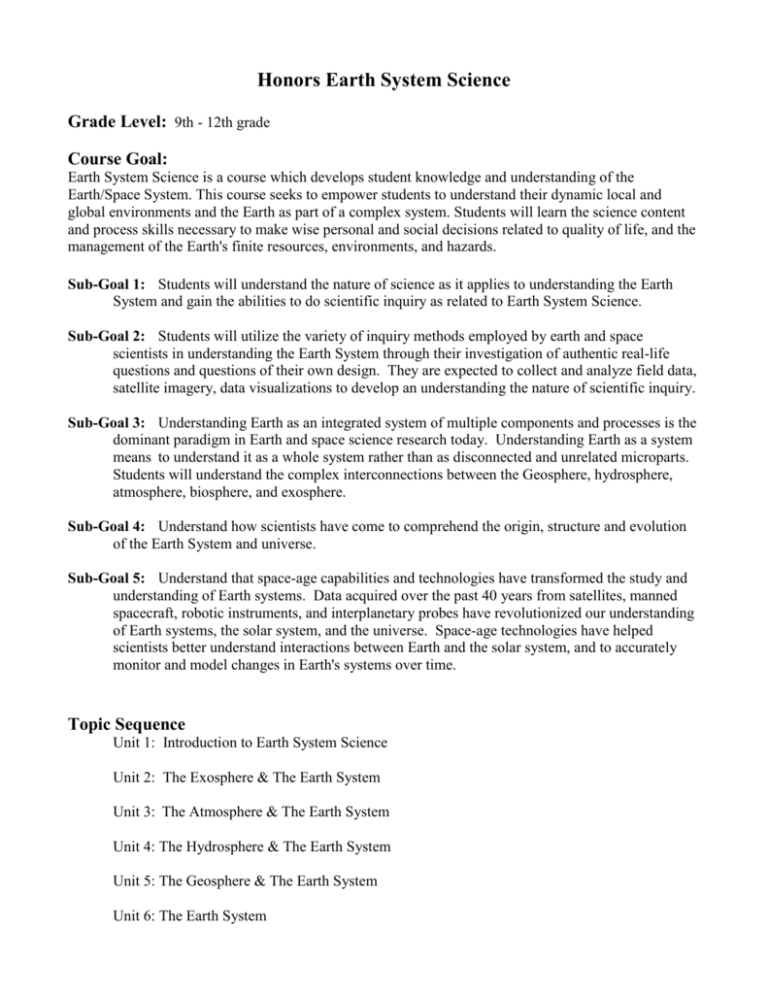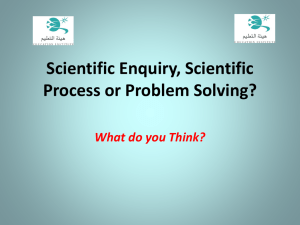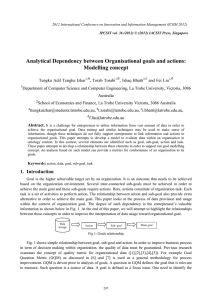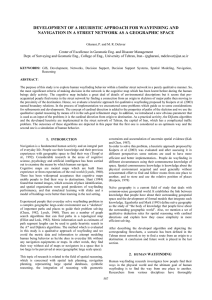Honors Earth System Science
advertisement

Honors Earth System Science Grade Level: 9th - 12th grade Course Goal: Earth System Science is a course which develops student knowledge and understanding of the Earth/Space System. This course seeks to empower students to understand their dynamic local and global environments and the Earth as part of a complex system. Students will learn the science content and process skills necessary to make wise personal and social decisions related to quality of life, and the management of the Earth's finite resources, environments, and hazards. Sub-Goal 1: Students will understand the nature of science as it applies to understanding the Earth System and gain the abilities to do scientific inquiry as related to Earth System Science. Sub-Goal 2: Students will utilize the variety of inquiry methods employed by earth and space scientists in understanding the Earth System through their investigation of authentic real-life questions and questions of their own design. They are expected to collect and analyze field data, satellite imagery, data visualizations to develop an understanding the nature of scientific inquiry. Sub-Goal 3: Understanding Earth as an integrated system of multiple components and processes is the dominant paradigm in Earth and space science research today. Understanding Earth as a system means to understand it as a whole system rather than as disconnected and unrelated microparts. Students will understand the complex interconnections between the Geosphere, hydrosphere, atmosphere, biosphere, and exosphere. Sub-Goal 4: Understand how scientists have come to comprehend the origin, structure and evolution of the Earth System and universe. Sub-Goal 5: Understand that space-age capabilities and technologies have transformed the study and understanding of Earth systems. Data acquired over the past 40 years from satellites, manned spacecraft, robotic instruments, and interplanetary probes have revolutionized our understanding of Earth systems, the solar system, and the universe. Space-age technologies have helped scientists better understand interactions between Earth and the solar system, and to accurately monitor and model changes in Earth's systems over time. Topic Sequence Unit 1: Introduction to Earth System Science Unit 2: The Exosphere & The Earth System Unit 3: The Atmosphere & The Earth System Unit 4: The Hydrosphere & The Earth System Unit 5: The Geosphere & The Earth System Unit 6: The Earth System Methods of Instruction A variety of methods of instruction will be used in this course and include: Inquiry Methods described above: The classic experiment Changes over time scales Using modern analogs Variation over space Using physical models Using computer models Multiple working hypotheses Computer activities and investigations Problem-based learning Unit challenge questions Concept mapping System modeling Field investigations Cooperative learning Traditional lectures and notes Individual research Instructional Materials Primary text: Earth Science, 11th Edition by: E. J. Tarbuck and F. K. Lutgens Prentice Hall, 2006 ISBN: 0-13-149751-0 A variety of computer desktop based and web-based computer tools will be used to take full advantage of real and archived data. Student Outcomes and Methods of Assessment Student performance will be assessed by the following methods: Formative Assessments such as quizzes Labs & Activities Chapter tests Unit Challenges & Unit tests Full/Open independent long-term inquiry project Alternative Assessment - end of year assessment integrating the content and skills acquired during the year. Cumulative Final Exam A point system is used to assess student progress. Approximately 400 points each marking period are available for students to earn.








